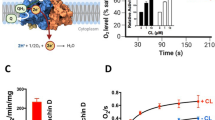Abstract
IN a rat-liver homogenate that has not been strongly diluted the mitochondria remain substantially unclumped for several hours even at room temperature ; but if it is diluted more than about five-fold with a medium containing electrolyte, serious clumping may occur in a few minutes. If it is diluted with the supernatant from another homogenate which has been only slightly diluted, clumping is almost completely inhibited. This shows that a natural antidumping factor is present in the supernatant. The factor is thermo-labile, non-dialysable and precipitable from supernatant by half-saturated ammonium sulphate. Its activity is lost gradually at 0° C. but is retained indefinitely at − 15° C. The lability suggests that it is not identical with heparin, which is known to prevent mitochondrial clumping. This is confirmed by the fact that our factor does not, like heparin, produce nuclear haloes1 by combining with histone and liberating deoxyribonucleic acid. On the other hand, all its properties known so far correspond with those of the ribonuclease inhibitor discovered by Roth2,3, which is also not identical with heparin although the latter inhibits ribonuclease. We therefore tested crystalline pancreatic ribonuclease for clumping activity and found it very potent in absence but not in presene of supernatant, as expected. Thus there is good reason for accepting as a working hypothesis that our antidumping factor and Roth's ribonuclease inhibitor are identical, though this can be established with certainty only by isolation of the two substances. Our factor, like Roth's, varies greatly in concentration in apparently similar preparations. One supernatant had perceptible antidumping activity at a dilution of 1/180, suggesting that even crude concentrates of the factor will be useful protectors in any experiments where mitochondria need to be kept in good condition.
This is a preview of subscription content, access via your institution
Access options
Subscribe to this journal
Receive 51 print issues and online access
$199.00 per year
only $3.90 per issue
Buy this article
- Purchase on Springer Link
- Instant access to full article PDF
Prices may be subject to local taxes which are calculated during checkout
Similar content being viewed by others
References
Anderson, N. G., and Wilbur, K. M., J. Gen. Physiol., 34, 647 (1951).
Roth, J. S., Biochim. Biophys. Acta, 21, 34 (1956).
Roth, J. S., J. Biol. Chem., 231, 1085 (1958).
Cooper, F. G., “Munsell Manual of Colour” (Munsell Color Co. Inc., Baltimore, Maryland, 1941).
Bourdillon, R. B., Bruce, H. M., Fishmann, C., and Webster, T. A., Medical Research Council Special Report Series No. 158 (H. M. Stationery Office No. 45–5–58, 1931).
Kendall, M. G., “Advanced Theory of Statistics”, 5th edit., Vol. 1, p 411 (C. Griffin and Co., Ltd., London, 1952).
Dickman, S. R., Aroskar, J. P., and Kropf, R. B., Biochim. Biophys. Acta, 21, 539 (1956).
Author information
Authors and Affiliations
Rights and permissions
About this article
Cite this article
PHILPOT, J., STANIER, J. An Anticlumping Factor for Mitochondria in the Supernatant Fraction of Rat-Liver Homogenates. Nature 182, 1167–1168 (1958). https://doi.org/10.1038/1821167a0
Issue Date:
DOI: https://doi.org/10.1038/1821167a0
Comments
By submitting a comment you agree to abide by our Terms and Community Guidelines. If you find something abusive or that does not comply with our terms or guidelines please flag it as inappropriate.



